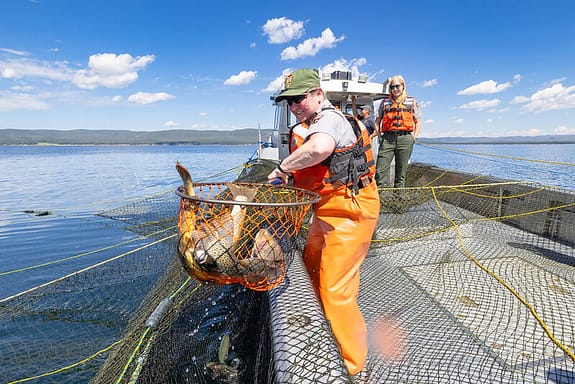Native Fish Conservation Program
Yellowstone National Park is home to one of the most pristine aquatic ecosystems on Earth. About five percent of the park is covered by water, including more than 220 lakes and 2,650 miles of streams. These waters support 12 species or subspecies of native fish, including Arctic grayling, mountain whitefish, westslope cutthroat trout, and Yellowstone cutthroat trout.
From the park emerge streams that join to become three of America’s most important waterways: the Yellowstone, the Missouri and the Snake rivers. At the heart of the park lies Yellowstone Lake. At an altitude of 7,730 feet, surface area of 136 square miles, and depth up to 400 feet, the lake is the largest alpine body of water in North America.

After non-native predatory lake trout were first detected in Yellowstone Lake in 1994, the Yellowstone cutthroat trout population have been in a dramatic decline. Since that time, park biologists have undertaken a monumental effort to remove lake trout from Yellowstone Lake and bring back Yellowstone cutthroat trout from the brink.
Through utilizing the best available science and a multi-faceted approach, Yellowstone’s Native Fish Program strives to face this ecological crisis head on in an effort to restore balance to the park’s complex and dynamic ecosystem. Yellowstone’s senior fisheries biologist, Todd Koel writes, “Our goal is as bold as it is difficult: restore the ecological role of Yellowstone’s native fish species.”
 Highlights
Highlights
-
The lake trout suppression program on Yellowstone Lake is one of the largest and longest-running nonnative fish suppression programs in existence.
-
Lake trout were first detected in Yellowstone Lake in 1994.
-
236,853 lake trout were removed by gillnetting crews in 2023. Over the past 28 years more than 4.5 million lake trout have been gillnetted.
-
Predatory lake trout (age 6 and older) have been reduced by an estimated 92%, from about 53,300 fish in 2012 to 4,000 in 2022.
-
Grizzly and black bears have responded to increases in spawning cutthroat trout by returning to some lake tributaries during spring to feed upon them.
-
Arctic grayling and cutthroat trout (Yellowstone, Westslope) have been preserved and restored (or ongoing) to about 163 stream miles and 282 lake acres outside of Yellowstone Lake.
Combatting Lake Trout
The primary activity of Yellowstone’s Native Fish Program is removal of the invasive lake trout from Yellowstone Lake. It’s astounding what harm a single invasive species can have on the Yellowstone ecosystem. Lake trout are predatory, and one mature lake trout can eat approximately 41 native cutthroat trout per year!
Most predators can’t catch lake trout as a substitute for the cutthroat because the lake trout live in deep water and are quite large. Because of this, lake trout have no natural predators in the park’s ecosystem, and can potentially live to their 30s and 40s in Yellowstone Lake if they are not removed by netting. The life span of cutthroat is typically 10-12 years.
Gill nets are the main tool used for catching and killing lake trout: panels of net extend upward from the bottom of the lake about six to eight feet high and for many miles. In tandem with gillnetting, park biologists use other effective monitoring and removal methods including telemetry and embryo suppression.
 Yellowstone Fly Fishing Volunteer Program
Yellowstone Fly Fishing Volunteer Program
The Yellowstone Fly Fishing Volunteer Program (YFFVP) is directed by Yellowstone National Park fisheries biologists and funded through public donations provided by Yellowstone Forever. Each year, volunteers from around the United States donate their time and resources to travel to Yellowstone to go “fly fishing for science.” The volunteers are led by the YFFVP’s coordinator into Yellowstone’s rivers, creeks, and lakes to conduct angling fieldwork research by collecting and recording data from the fish they catch. Over the course of its 21-year history, the Yellowstone Fly Fishing Volunteer Program has become a vital and unique tool to aid park biologists as they work to manage and better understand Yellowstone’s prolific and diverse fisheries.
For more information, contact YFFVP coordinator Paul Weamer through this form. To support the program, click on the button below. Thank you!
DONATE TODAYOther Native Fish Restoration Efforts
The park’s fisheries biologists are working on a number of other priority native fish restoration projects throughout the park. Many native and non-native fish were actually stocked in park waters throughout the late 1800s to mid 1900s for sport fishing purposes, which has had deleterious consequences in other regions and streams outside of Yellowstone Lake. Rainbow trout, brook trout, brown trout and lake trout have taken hold in many lakes, rivers, and streams. Although non-native trout are also important to the angler experience in Yellowstone, they have contributed to a decline in the park’s native cutthroat trout and fluvial arctic grayling. Many of these efforts are outlined in the latest Native Fish Conservation Program update from the park below.
How You Can Help
The ecological health and well-being of Yellowstone cutthroat trout, Yellowstone Lake, and Yellowstone National Park are in our hands. With your help, we have been proud to support these daunting but effective efforts each year. The work done by the Native Fish Conservation Program is indeed working! Annual support is needed to ensure we preserve Yellowstone’s native trout and the ecosystem that relies on them.
 Highlights
Highlights
 Yellowstone Fly Fishing Volunteer Program
Yellowstone Fly Fishing Volunteer Program